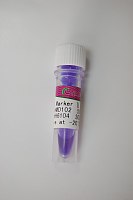ChIP‐exo Method for Identifying Genomic Location of DNA‐Binding Proteins with Near‐Single‐Nucleotide Accuracy
互联网
- Abstract
- Table of Contents
- Materials
- Figures
- Literature Cited
Abstract
This unit describes the ChIP?exo methodology, which combines chromatin immunoprecipitation (ChIP) with lambda exonuclease digestion followed by high?throughput sequencing. ChIP?exo allows identification of a nearly complete set of the binding locations of DNA?binding proteins at near?single?nucleotide resolution with almost no background. The process is initiated by cross?linking DNA and associated proteins. Chromatin is then isolated from nuclei and subjected to sonication. Subsequently, an antibody against the desired protein is used to immunoprecipitate specific DNA?protein complexes. ChIP DNA is purified, sequencing adaptors are ligated, and the adaptor?ligated DNA is then digested by lambda exonuclease, generating 25? to 50?nucleotide fragments for high?throughput sequencing. The sequences of the fragments are mapped back to the reference genome to determine the binding locations. The 5? ends of DNA fragments on the forward and reverse strands indicate the left and right boundaries of the DNA?protein binding regions, respectively. Curr. Protoc. Mol. Biol. 100:21.24.1?21.24.14. © 2012 by John Wiley & Sons, Inc.
Keywords: ChIP; ChIP?exo; binding location; genome?wide; lambda exonuclease
Table of Contents
- Introduction
- Basic Protocol 1: Identification of Protein‐DNA Binding Sites in Saccharomyces cerevisiae by ChIP‐exo
- Alternate Protocol 1: Identification of Protein‐DNA Binding Sites in Mammalian Cells by ChIP‐exo
- Reagents and Solutions
- Commentary
- Literature Cited
- Figures
- Tables
Materials
Basic Protocol 1: Identification of Protein‐DNA Binding Sites in Saccharomyces cerevisiae by ChIP‐exo
Materials
Table 1.4.1 MaterialsOligonucleotides for Library Construction
Alternate Protocol 1: Identification of Protein‐DNA Binding Sites in Mammalian Cells by ChIP‐exo
|
Figures
-
Figure 21.24.1 Scheme for ChIP‐exo. After ChIP, 3′ sonicated ends are demarcated from the eventual exonuclease‐treated 5′ end by ligating the P2‐T adaptor to the ChIP DNA on the resin prior to exonuclease digestion. Then, 5′‐to‐3′ exonuclease trimming up to the site of cross‐linking selectively eliminates the P2‐T adaptor sequence attached at the 5′ end of each strand. After cross‐link reversal, eluted single‐stranded DNA is made double‐stranded by P2 PCR primer extension. Finally, a P1‐T adaptor is ligated to the exonuclease‐treated end, and the resulting library is subjected to high‐throughput sequencing. Mapping the 5′ ends of the resulting sequencing tags to the reference genome demarcates the exonuclease barrier and thus the precise site of protein‐DNA cross‐linking (adapted from Rhee and Pugh, ). View Image
Videos
Literature Cited
| Dai, S.M., Chen, H.H., Chang, C., Riggs, S.D., and Flanagan, S.D. 2000. Ligation‐mediated PCR for quantitative in vivo footprinting. Nat. Biotechnol. 18:1108‐1111. | |
| Lee, T.I., Rinaldi, N.J., Robert, F., Odom, D.T., Bar‐Joseph, Z., Gerber, G.K., Hannett, N.M., Harbison, C.T., Thompson, C.M., Simon, I., Zeitlinger, J., Jennings, E.G., Murray, H.L., Gordon, D.B., Ren, B., Wyrick, J.J., Tagne, J.B., Volkert, T.L., Fraenkel, E., Gifford, D.K., and Young, R.A. 2002. Transcriptional regulatory networks in Saccharomyces cerevisiae. Science 298:799‐804. | |
| Little, J.W. 1981. Lambda exonuclease. Gene Amplif. Anal. 2:135‐145. | |
| Lovett, S.T. and Kolodner, R.D. 1989. Identification and purification of a single‐stranded‐DNA‐specific exonuclease encoded by the recJ gene of Escherichia coli. Proc. Natl. Acad. Sci. U.S.A. 86:2627‐2631. | |
| Peng, S., Alekseyenko, A.A., Larschan, E., Kuroda, M.I., and Park, P.J. 2007. Normalization and experimental design for ChIP‐chip data. BMC Bioinformatics 8:219. | |
| Ptashne, M. and Gann, A. 1997. Transcriptional activation by recruitment. Nature 386:569‐577. | |
| Rhee, H.S. and Pugh, B.F. 2011. Comprehensive genome‐wide protein‐DNA interactions detected at single‐nucleotide resolution. Cell 147:1408‐1419. | |
| Rhee, H.S. and Pugh, B.F. 2012. Genome‐wide structure and organization of eukaryotic pre‐initiation complexes. Nature 483:295‐301. | |
| Rozowsky, J., Euskirchen, G., Auerbach, R.K., Zhang, Z.D., Gibson, T., Bjornson, R., Carriero, N., Snyder, M., and Gerstein, M.B. 2009. PeakSeq enables systematic scoring of ChIP‐seq experiments relative to controls. Nat. Biotechnol. 27:66‐75. | |
| Rychlik, W., Spencer, W.J., and Rhoads, R.E. 1990. Optimization of the annealing temperature for DNA amplification in vitro. Nucl. Acids Res. 18:6409‐6412. | |
| Struhl, K. 1995. Yeast transcriptional regulatory mechanisms. Annu. Rev. Genet. 29:651‐674. | |
| Tuteja, G., White, P., Schug, J., and Kaestner, K.H. 2009. Extracting transcription factor targets from ChIP‐Seq data. Nucleic Acids Res. 37:e113. | |
| Key Reference | |
| Rhee and Pugh, 2011. See above. | |
| First description of ChIP‐exo method for various transcription factors in species ranging from yeast to human. This paper shows the proof of principle of ChIP‐exo, identifying a nearly complete set of genomic binding sites at near‐single‐nucleotide resolution. |









